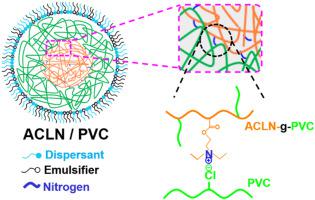当前位置:
X-MOL 学术
›
Polym. Test.
›
论文详情
Our official English website, www.x-mol.net, welcomes your
feedback! (Note: you will need to create a separate account there.)
One-pot polyvinyl chloride preparation utilizing polyacrylate latex with tertiary amine groups for improved thermal stability, toughness, and reduced reactor scaling
Polymer Testing ( IF 5.0 ) Pub Date : 2020-10-01 , DOI: 10.1016/j.polymertesting.2020.106691 Qingchen Yang , Yuzheng Xia , Dong Zhang , Xining Wang , Susan Oliver , Xiaonong Chen , Shuxian Shi , Lei Lei
Polymer Testing ( IF 5.0 ) Pub Date : 2020-10-01 , DOI: 10.1016/j.polymertesting.2020.106691 Qingchen Yang , Yuzheng Xia , Dong Zhang , Xining Wang , Susan Oliver , Xiaonong Chen , Shuxian Shi , Lei Lei

|
Abstract In this paper, crosslinked polyacrylate latex with tertiary amine groups (ACLN) and base latex without tertiary amine groups (ACL) were prepared by emulsion polymerization using butyl acrylate as the monomer and 1,4-butanediol dimethacrylate as the crosslinker. Composite resins of polyvinyl chloride (PVC), ACL/PVC and ACLN/PVC, were prepared by suspension polymerization of vinyl chloride in a 20 L high-pressure reactor by adding ACL and ACLN as modifiers. The inner pressure of the reactor and initiator concentration as a function of reaction time during suspension polymerization were studied. Morphology of resin particles, processing properties, thermal stability and mechanical properties of ACL/PVC and ACLN/PVC products were investigated. A commercial PVC product named PVC-SG5 was used as the control sample for comparison. It was found that compared with typical PVC-SG5 preparation, ACL/PVC fabrication took less time while initiator concentrations needed to be increased to 2400 ppm in ACLN/PVC preparation in order to complete the polymerization within the same time. Reactor scaling occurred during ACL/PVC preparation, but could be avoided in ACLN/PVC preparation owing to the hydrophilicity of ACLN. The morphology of ACL/PVC and ACLN/PVC particles was smooth microspheres and mosaic particle shapes, respectively, the diameter of which were all smaller than PVC-SG5 particles. The covalent-bonding existing in ACL/PVC and ACLN/PVC, and ionic-bond formation of quaternary ammonium in ACLN/PVC composite resins, between tertiary amine groups in ACLN and chlorine atoms in PVC, contributed to the dramatic increase in thermal stability. ACLN/PVC exhibited the shortest plasticizing time and the longest elongation at break, followed by ACL/PVC. The toughness of both ACL/PVC and ACLN/PVC were greatly enhanced without affecting the tensile strength and softening temperature of the resin. Thus, three issues, namely, low thermal stability, low toughness and reactor scaling during polymerization of PVC have been comprehensively solved by introducing ACLN to PVC through a one-pot method.
中文翻译:

利用具有叔胺基团的聚丙烯酸酯胶乳的一锅聚氯乙烯制备,以提高热稳定性、韧性并减少反应器结垢
摘要 本文以丙烯酸丁酯为单体,二甲基丙烯酸1,4-丁二醇为交联剂,通过乳液聚合制备了具有叔胺基团的交联聚丙烯酸酯胶乳(ACLN)和不含叔胺基团的基础胶乳(ACL)。加入ACL和ACLN作为改性剂,在20L高压反应釜中悬浮聚合氯乙烯,制备了聚氯乙烯(PVC)、ACL/PVC和ACLN/PVC复合树脂。研究了反应器的内部压力和引发剂浓度作为悬浮聚合过程中反应时间的函数。研究了ACL/PVC和ACLN/PVC制品的树脂颗粒形貌、加工性能、热稳定性和机械性能。使用名为 PVC-SG5 的商品 PVC 产品作为对照样品进行比较。结果发现,与典型的 PVC-SG5 制备相比,ACL/PVC 制备所需的时间更短,而 ACLN/PVC 制备中的引发剂浓度需要增加到 2400 ppm,以便在同一时间内完成聚合。ACL/PVC 制备过程中会发生反应器结垢,但由于 ACLN 的亲水性,可以在 ACLN/PVC 制备过程中避免结垢。ACL/PVC和ACLN/PVC颗粒的形态分别为光滑的微球和镶嵌颗粒形状,粒径均小于PVC-SG5颗粒。ACL/PVC 和 ACLN/PVC 中存在的共价键,ACLN/PVC 复合树脂中季铵的离子键形成,ACLN 中的叔胺基团与 PVC 中的氯原子之间的离子键,有助于热稳定性的显着提高。ACLN/PVC 的塑化时间最短,断裂伸长率最长,其次是 ACL/PVC。ACL/PVC 和 ACLN/PVC 的韧性都大大增强,而不会影响树脂的拉伸强度和软化温度。因此,通过一锅法将ACLN引入PVC,全面解决了PVC聚合过程中热稳定性低、韧性低和反应器结垢三个问题。
更新日期:2020-10-01
中文翻译:

利用具有叔胺基团的聚丙烯酸酯胶乳的一锅聚氯乙烯制备,以提高热稳定性、韧性并减少反应器结垢
摘要 本文以丙烯酸丁酯为单体,二甲基丙烯酸1,4-丁二醇为交联剂,通过乳液聚合制备了具有叔胺基团的交联聚丙烯酸酯胶乳(ACLN)和不含叔胺基团的基础胶乳(ACL)。加入ACL和ACLN作为改性剂,在20L高压反应釜中悬浮聚合氯乙烯,制备了聚氯乙烯(PVC)、ACL/PVC和ACLN/PVC复合树脂。研究了反应器的内部压力和引发剂浓度作为悬浮聚合过程中反应时间的函数。研究了ACL/PVC和ACLN/PVC制品的树脂颗粒形貌、加工性能、热稳定性和机械性能。使用名为 PVC-SG5 的商品 PVC 产品作为对照样品进行比较。结果发现,与典型的 PVC-SG5 制备相比,ACL/PVC 制备所需的时间更短,而 ACLN/PVC 制备中的引发剂浓度需要增加到 2400 ppm,以便在同一时间内完成聚合。ACL/PVC 制备过程中会发生反应器结垢,但由于 ACLN 的亲水性,可以在 ACLN/PVC 制备过程中避免结垢。ACL/PVC和ACLN/PVC颗粒的形态分别为光滑的微球和镶嵌颗粒形状,粒径均小于PVC-SG5颗粒。ACL/PVC 和 ACLN/PVC 中存在的共价键,ACLN/PVC 复合树脂中季铵的离子键形成,ACLN 中的叔胺基团与 PVC 中的氯原子之间的离子键,有助于热稳定性的显着提高。ACLN/PVC 的塑化时间最短,断裂伸长率最长,其次是 ACL/PVC。ACL/PVC 和 ACLN/PVC 的韧性都大大增强,而不会影响树脂的拉伸强度和软化温度。因此,通过一锅法将ACLN引入PVC,全面解决了PVC聚合过程中热稳定性低、韧性低和反应器结垢三个问题。











































 京公网安备 11010802027423号
京公网安备 11010802027423号